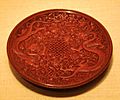Orange-red facts for kids
| This box shows the color orange-red. |
|---|
Orange-red is a color. It is a combination of red and orange.
Tones of orange-red color comparison chart
- Melon (Crayola) (Hex: #FEBAAD) (RGB: 254, 186, 173)
- Light Salmon Pink (Hex: #FF9999) (RGB: 255, 153, 153)
- Salmon Pink (Crayola "Salmon") (Hex: #FF91A4) (RGB: 255, 145, 164)
- Medium Salmon (Hex: #FF8C69) (RGB: 255, 140, 105)
- Salmon (web color) (Hex: #FA8072) (RGB: 250, 128, 114)
- Coral Pink (Hex: #F88379) (RGB: 248, 131, 121)
- Light Coral (web color) (Hex: #F08080) (RGB: 240, 128, 128)
- Bittersweet (Crayola) (Hex: #FE6F5E) (RGB: 254, 111, 94)
- Terracotta (Hex: #E2725B) (RGB: 226, 114, 91)
- Tea Rose (orange) (Hex: #F88379) (RGB: 248, 131, 121)
- Vivid Tangerine (Crayola) (Tangerine Sherbet) (Hex: #FF9980) (RGB: 255, 153, 128)
- Atomic Tangerine (Crayola) (Hex: #FF9966) (RGB: 255, 153, 102)
- Tangerine (Hex: #F28500) (RGB: 243, 132, 0)
- Pumpkin (Hex: #FF7518) (RGB: 152, 118, 54)
- Rich Orange (Crayola Orange) (Hex: #FF681F) (RGB: 255, 104, 31)
- Safety Orange (Blaze Orange) (Hex: #FF6600) (RGB: 255, 102, 0)
- Cadmium Orange (Xona.com Color List) (Hex: #FF6103) (RGB: 255, 97, 3)
- Persimmon (Hex: #EC5800) (RGB: 236, 88, 0)
- Tangelo (Hex: #F94D00) (RGB: 249, 77, 0)
- Vermilion (Cinnabar) (Hex: #F34234) (RGB: 227, 66, 52)
- Coquelicot (Red Poppy) (Hex: #FF3800) (RGB: 255, 56, 0)
- Medium Vermilion (Plochere Vermilion) (Hex: #D9603B) (RGB: 217, 96, 59)
- Red-Orange (Crayola) (Hex: #FF3F34) (RGB: 255, 63, 52)
- Mandarin Red (Electric Vermilion) (Hex: #FF3F00) (RGB: 255, 63, 0)
- Orange-Red (web color) (Hex: #FF4500) (RGB: 255, 69, 0)
- Sunny Orange (Colour Lovers 2010 Color of the Year) (Hex: #FC5110) (RGB: 252, 81, 16)
- International Orange (Hex: #FF4F00) (RGB: 255, 79, 0)
- Ultra Orange (Crayola) (Outrageous Orange) (Hex: #FF6037) (RGB: 255, 96, 55)
- Tomato (web color) (Hex: #FF6347) (RGB: 255, 99, 71)
- Tenne (Tawny) (Hex: #CD5700) (RGB: 205, 87, 0)
- Burnt Orange (Hex: #CC5500) (RGB: 204, 85, 0)
- Mahogany (Hex: #C04000) (RGB: 192, 64, 0)
- Dark Terra Cotta (Hex: #CC4E3C) (RGB: 204, 78, 92)
- Dark Coral (Hex: #CD5B45) (RGB: 205, 91, 69)
- Chestnut (Indian Red [web color]) (Hex: #CD5C5C) (RGB: 205, 92, 92)
- Deep Chestnut (Vermont Maple Syrup) (Crayola Chestnut) (Hex: #B94E48) (RGB: 185, 78, 72)
- Red-Brown (web color Brown) (Hex: #A52A2A) (RGB: 165, 42, 42)
- Cognac (Xona.com Color List) (Hex: #9F381D) (RGB: 159, 56, 29)
- Rust (Hex: #B7410E) (RGB: 183, 65, 14)
Related pages
Images for kids
-
The Venetian painter Titian used vermilion for dramatic effect. In the Assumption of the Virgin (1516–18) the vermilion robes draw the eye to the main characters.
-
Cinnabar crystals from the Almaden Mine in northern California
-
Cinnabar crystals on dolomite from Tongren Prefecture, Guizhou, China
-
Vermilion has the defect of darkening with time. The bridle of the horse in The Battle of San Romano by Paolo Uccello in the National Gallery in London has turned from red to dark brown.
-
The first documented use of cinnabar or vermilion pigment was found at the neolithic village of Çatalhöyük in modern-day Turkey. This mural, from 7000–8000 BC, shows aurochs, a deer and humans. (Museum of Anatolian Civilizations, Ankara)
-
The first documented use of cinnabar, or vermilion, for decorating pottery in China dates to the Yangshao culture (5000–4000 BC). This bowl is from Banpo Village, Shaanxi, China.
-
The Villa of the Mysteries in Pompeii was a showcase for the expensive vermilion pigment made from ground cinnabar.
-
The walls of the tombs of Maya rulers were sometimes painted with cinnabar, and in the Tomb of the Red Queen in Palenque (600–700 AD), the remains of a noblewoman were covered with bright vermilion cinnabar powder.
-
A lacquerware bowl from the Western Han Dynasty, 2nd century BC (Metropolitan Museum of Art, New York)
-
A lacquerware tray from the Song Dynasty, 960-1279 (Freer and Sackler Galleries, Washington, D.C.)
-
A lacquerware dish from the Ming Dynasty, late 15th to mid-16th century (Freer and Sackler Galleries, Washington, D.C.)
-
The main gate of the Shaolin Monastery in Dengfeng, Henan is painted vermilion or Chinese red.
-
Vermilion columns in the throne room in the Palace of Heavenly Purity in the Forbidden City of Beijing
-
The painting of Saint Jerome by Masaccio (1428–29) featured a vivid robe painted with vermilion.
-
Theyyam of Kerala





















